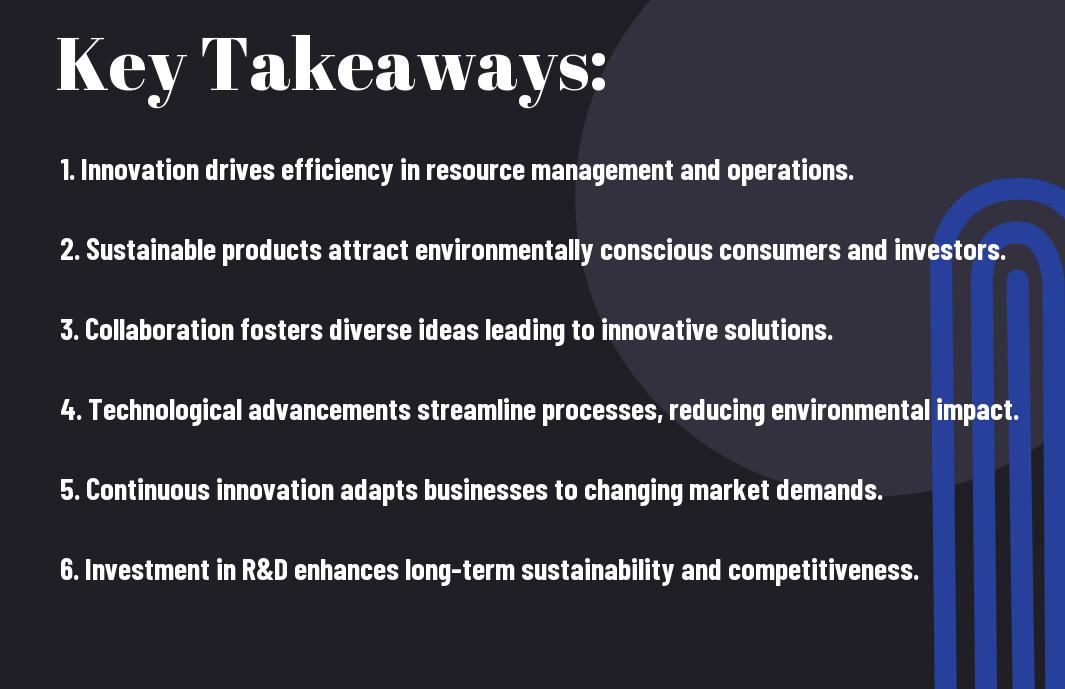
With the increasing pressures of climate change and resource scarcity, you may be wondering how innovation can enhance your business’s sustainability efforts. Embracing innovative practices allows you to not only streamline operations and reduce waste but also create new products that resonate with environmentally conscious consumers. By integrating innovative strategies, you can strengthen your brand’s reputation and contribute positively to the planet while ensuring long-term profitability. This post explores how you can leverage innovation to drive sustainability within your business.

Understanding Business Sustainability
Before delving into the specifics, it’s important to grasp what business sustainability encompasses. It integrates economic viability, environmental health, and social equity, ensuring that your organization can thrive while respecting the planet and its inhabitants. By incorporating sustainable practices, you not only contribute positively to society but also enhance your brand reputation, thereby attracting more customers and investors who value ethical practices.
Definition and Importance
By adopting a mindset of sustainability, you position your business to make responsible decisions that favor long-term success over short-term gains. This approach encompasses not only environmental stewardship but also social responsibility and economic resilience, making it imperative for businesses aiming for enduring growth. Understanding its importance can direct you towards effective strategies that align with your core values while meeting market demands.
Key Challenges in Achieving Sustainability
Business sustainability faces multiple challenges that can hinder your organization’s progress. Economic constraints, lack of stakeholder engagement, and insufficient knowledge of sustainable practices are just a few obstacles you may encounter as you attempt to integrate sustainability into your operations.
A key challenge in achieving sustainability lies in the initial investment required for green technology and practices. While pursuing eco-friendly systems can lead to long-term savings and improved efficiency, the upfront costs can be a barrier. Additionally, aligning all stakeholders on sustainability goals can prove difficult, as varying interests and priorities may conflict. Navigating regulatory complexities and staying updated with sustainability trends further complicates the landscape, demanding continuous learning and adaptation on your part.
The Concept of Innovation
Now, innovation refers to the implementation of new ideas, products, or processes that enhance business performance and contribute to sustainability. It transcends traditional methods, focusing on adapting to market changes, improving efficiency, and meeting customer needs. In a competitive landscape, harnessing innovation can position your business as a leader and drive long-term success.
Types of Innovation in Business
Now, understanding the different types of innovation can help you identify opportunities within your business. Key types include:
- Product Innovation
- Process Innovation
- Business Model Innovation
- Market Innovation
- Social Innovation
Any efforts in these areas can lead to enhanced efficiency and better sustainability outcomes.
| Type of Innovation | Description |
| Product Innovation | Developing new or improved goods to meet market needs. |
| Process Innovation | Enhancing methods of production and delivery. |
| Business Model Innovation | Redefining ways to create, deliver, and capture value. |
| Market Innovation | Targeting new customer segments or geographic regions. |
| Social Innovation | Creating solutions to societal challenges. |
The Innovation Process
Innovation is a structured approach that involves several stages, from idea generation to implementation and evaluation. Your ability to navigate this process effectively can set your business apart in achieving sustainability. Each step requires strategic consideration to align with your overall goals.
Indeed, the innovation process typically encompasses stages such as ideation, design, prototyping, testing, and final implementation. Engaging your team in brainstorming and evaluating ideas fosters creativity and sets the foundation for actionable solutions. By cultivating an innovative culture within your organization, you can continuously adapt to changing market demands and improve your sustainability practices.
The Intersection of Innovation and Sustainability
Not all businesses realize that embracing innovation can significantly enhance their sustainability efforts. By integrating innovative practices, you can not only reduce your environmental footprint but also create long-term value for your organization. When sustainability and innovation intersect, they enable you to develop new solutions, optimize resources, and ultimately contribute to a healthier planet while maintaining competitive advantage.
How Innovation Drives Sustainable Practices
Beside enhancing efficiency, innovation enables you to create sustainable practices that align with modern consumer expectations. By leveraging new technologies, such as renewable energy sources and smart systems, you can reduce waste, improve supply chain transparency, and foster a culture of responsibility. This holistic approach not only enhances your business model but also engages your customers in your sustainability journey.
Case Studies of Successful Innovative Sustainability
To illustrate the effectiveness of innovative sustainability strategies, here are some compelling case studies:
- Unilever: Aiming to halve its environmental impact by 2030, the company implemented eco-design principles, leading to a 30% reduction in carbon footprint across its product lifecycle.
- Tesla: By producing electric vehicles and solar energy products, Tesla reported a revenue increase of 47% from 2019 to 2020 while simultaneously reducing reliance on fossil fuels.
- Patagonia: The outdoor apparel brand invests 1% of its sales to environmental initiatives and has seen a brand loyalty increase of 30%, proving sustainability can drive consumer behavior.
- Danone: This company focuses on circular economy initiatives, successfully reducing plastic usage by 20% in its bottled water segment in just two years.
Indeed, these case studies demonstrate that innovative sustainability is not just theory but a practical pathway for success. By implementing similar strategies, you can elevate your business’s mission while ensuring profitability. Engaging with sustainable innovation allows you to capture market opportunities, thus enhancing your brand image and drawing in consumers who prioritize environmental stewardship.
The Role of Technology in Sustainable Innovation
Your business can significantly benefit from technological advancements that promote sustainable innovation. By integrating modern technologies into your operations, you can streamline processes, reduce waste, and ultimately enhance your environmental performance. Embracing these innovations allows you to meet your sustainability goals while remaining competitive in an increasingly eco-conscious market.
Emerging Technologies and Their Impact
Against a backdrop of urgent environmental challenges, emerging technologies are transforming the landscape of sustainable innovation. Innovations such as artificial intelligence, blockchain, and advanced materials are equipping businesses like yours with tools to optimize resource use, enhance efficiency, and minimize environmental impact, paving the way towards a more sustainable future.
Digital Transformation and Eco-Friendly Solutions
Above all, digital transformation is vital for fostering eco-friendly solutions in your business. By adopting digital tools and platforms, you can improve operational efficiencies, increase transparency, and minimize your carbon footprint.
Considering the evolving landscape of digital solutions, many businesses are leveraging technology to create eco-friendly alternatives. Tools like IoT devices enable real-time monitoring of resource consumption, while cloud computing facilitates data-driven strategies for waste reduction. By embracing these digital transformations, you can enhance your operational performance while contributing to a more sustainable future. Utilizing analytics can further help you identify inefficiencies and track progress towards your sustainability goals.
Strategies for Fostering Innovation in Sustainable Business
All businesses aiming for sustainability must adopt innovative strategies to thrive in a competitive and eco-conscious landscape. Implementing practices that encourage creative thinking, effective collaboration, and knowledge sharing will empower you to develop solutions that address environmental challenges while enhancing your operational efficiency. By integrating innovation into your business strategy, you can drive growth and resilience in your sustainability efforts.
Building a Culture of Innovation
Below, fostering a culture of innovation within your organization involves creating an environment where employees feel empowered to share ideas and take risks. Encourage open communication, celebrate creative problem-solving, and provide opportunities for continuous learning. By prioritizing these elements, you can inspire your workforce to think outside the box and contribute innovative solutions that enhance your sustainability mission.
Collaboration and Partnerships
About collaboration and partnerships, building strong relationships with other organizations can significantly enhance your innovation efforts. Engaging with industry peers, non-profits, academia, and even competitors can lead to the sharing of valuable insights and resources. By pooling knowledge and expertise, you can explore new technologies, share best practices, and ultimately develop sustainable solutions that benefit both your business and the environment.
Another effective approach to encourage collaboration is to participate in industry networks and sustainability initiatives. By engaging in joint ventures or co-innovation projects, you can unlock new opportunities to address shared challenges. This cooperative mindset not only leads to innovative solutions but also helps to strengthen your brand reputation as a responsible and forward-thinking organization committed to sustainability.
Measuring the Impact of Innovation on Sustainability
Once again, assessing the impact of innovation on sustainability requires a systematic approach. You can employ various methods to analyze how new practices, products, or technologies contribute to sustainable development goals. This includes tracking resource efficiency, carbon footprint reduction, and social wellbeing. By evaluating these metrics over time, you can better understand the effectiveness of your innovations and make informed decisions moving forward.
Key Performance Indicators
To effectively measure innovation’s impact on sustainability, you should establish clear Key Performance Indicators (KPIs). These KPIs can include energy consumption, waste reduction, and supply chain sustainability. By selecting relevant indicators tailored to your specific goals, you enable yourself to track progress, evaluate performance, and make data-driven improvements as needed.
Reporting and Accountability
For your efforts to yield meaningful results, you must emphasize reporting and accountability. Transparent reporting not only showcases your commitment to sustainability but also allows stakeholders to hold you accountable for your innovations and practices.
Performance indicators should be regularly reviewed and disclosed to relevant stakeholders in a comprehensible manner. By doing so, you create trust and engagement, demonstrating that you are serious about your sustainability commitments. This transparency helps identify areas for improvement and can foster collaborative efforts toward achieving broader sustainability goals. Ensuring accountability in your innovations leads to credibility, enhancing your brand’s reputation and stakeholder trust.
Conclusion
Considering all points, you can see that innovation plays a vital role in achieving business sustainability. By embracing new technologies and sustainable practices, you position your business to adapt to changing market demands while reducing environmental impact. Engaging in innovative solutions not only enhances your competitive advantage but also fosters customer loyalty and trust. Thus, integrating innovation into your sustainability strategy is necessary for long-term success and resilience in an ever-evolving marketplace.
Leave a Reply